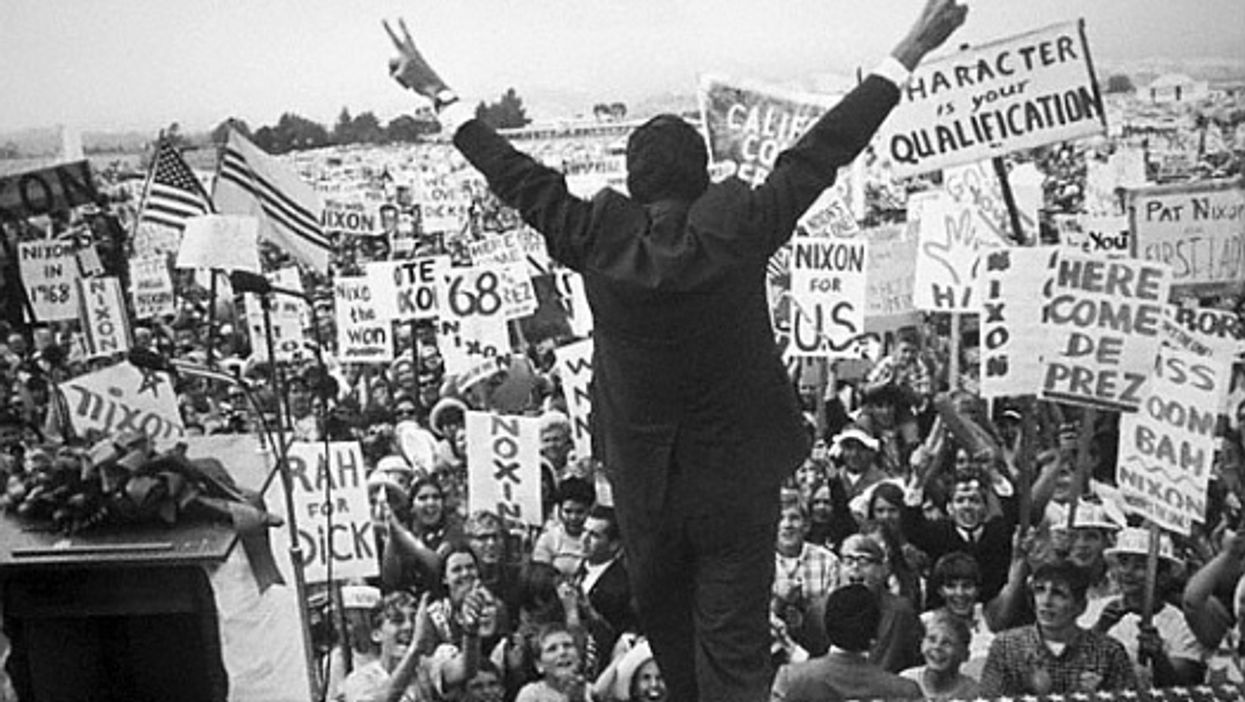
Richard Nixon at a campaign rally in 1968
Reprinted with permission from Alternet
Nineteen-sixty-eight was one of the most tumultuous years in American history. Cities across the country burned after the assassination of Martin Luther King. Robert Kennedy was gunned down a few months later. There was a lot of crime, and widespread unrest in response to the seemingly endless war in Vietnam. A bloody police riot marred the Democratic National Convention.
That was the year Richard Nixon unveiled his "Southern Strategy," pivoting to a law and order message against liberal Democrat Hubert Humphrey, whom he painted as soft on crime and someone who coddled those dirty hippies. The campaign carried racial undertones that weren't exactly subtle, but were sufficiently implicit to distinguish him from third party candidate George Wallace, the fiery Dixiecrat who had gained national notoriety for his staunch opposition to black civil rights.
In 2016, historian Josh Zeitz wrote that, "by focusing incessantly on racially coded issues like crime and urban unrest, Nixon signaled to white voters that he offered a respectable alternative to Wallace."
Campaigning throughout the upper South, he endorsed the Supreme Court's decision in Brown v. Board of Education, which banned segregation in public schools, but also assured white voters that he felt it was wrong for the federal government to "force a local community to carry out what a federal administrator or bureaucrat may think is best for that local community." Even the conservative Wall Street Journal criticized Nixon's "harsh and strident efforts to capitalize on deep-seated discontent and frustration. This is the Richard Nixon who tells a whistle-stop rally in Deshler, Ohio that in the 45 minutes since his train left Lima, one murder, two rapes and 45 major crimes of violence had occurred in this country—and that 'Hubert Humphrey defends the policies under which we have seen crime rise to this point.'"
It worked. Nixon won 14 more states than two his rivals combined. Four years later, in 1972–and 18 months after four protestors were shot down by National Guard troops at Kent State University–he won every state except Massachusetts. Republicans have, to varying degrees, employed that strategy ever since.
It's easy to forget that the 2016 Republican National Convention opened with the theme, "Make America Safe Again." Trump's campaign echoed Nixon's, as he claimed that he spoke for the "forgotten men and women" of America and would stand tall against Mexican rapists and the forces of "political correctness." It was all about leveraging white Americans' cultural grievances and anxiety about globalization and demographic change.
With his late-night tweets calling the people out protesting the police slaying of another unarmed black man in Minneapolis "thugs" and warning that "when the looting starts, the shooting starts," it's a safe bet that Trump will attempt to use today's unrest to deflect from his utter failure to contain the Covid-19 pandemic.
There are three good reasons to think it won't work.
First, Nixon was taciturn, serious and experienced. As Josh Zeitz wrote, he "walked a thin line between statesmanship and demagoguery," which is something that Trump, who has no discipline whatsoever and is the antithesis of a statesman, is incapable of doing. Nixon was able to pitch himself as a stabilizing force–a rock in a sea of chaos; Trump is himself an agent of chaos. A majority of Americans think he's racist and uniquely divisive. Those yearning for stability and a return to "normalcy," have an alternative in Joe Biden, a veteran moderate Democrat who's served in government for decades and tends to speak in soothing tones. Biden's leading Trump by a mile among voters who dislike both candidates.
Second, it didn't work in 2016. Not only did he lose the popular vote by almost 3 million ballots, but the data show that he almost certainly would have lost the Electoral College as well if not for former FBI Director James Comey announcing that he was reopening the probe into Hillary Clinton's emails 11 days before the vote.
It also didn't help his party in the 2018 midterms, when Trump spent months railing about an "invasion" by a caravan of refugees making their way north to the United States through Mexico.
Finally, it's simply the case that nothing seems to move the needle on Trump's popularity with the public, or lack thereof. Opinions are set. He ended 2019 with a 42.6 percent approval rating in FiveThirtyEight's average, and today–after 100,000 mostly avoidable deaths, 40 million lost jobs and a couple of stock market sell-offs–that number stands at 42.6 percent.
Ultimately, Trump's Nixonian pitch appeals to his hardcore base–the approximately 25 percent of voters who hold a "very favorable" view of his performance. It's safe to assume that they celebrated his talk of shooting "thugs." But there's no reason to think it will resonate beyond MAGA nation, and every reason to believe it turns off more Americans than it energizes.
- Trump Adversaries: Don't Riot. Organize! - National Memo ›
- Neo-Nazi Convicted Of Murder In Charlottesville Riot - National Memo ›
- Feds Indict Four More White Supremacists On Riot Charges ... ›
- As Trump Hides In White House, Internet Rips His ‘Cowardice’ ›
- Biden Meets Protesters On Street While Trump Tweets From Bunker - National Memo ›
- ‘Law And Order’ Is Trump’s Only Play ›
- Danziger Draws - National Memo ›
- Biden Is Stuck In The Middle, Comfortably - National Memo ›
- Neither Law Nor Order, But Bloody Chaos - National Memo ›
- Right-Wingers Insist They’re The Victims Of Trump Insurrection - National Memo ›








